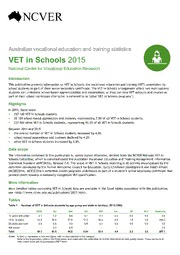
ERIC ED568372: VET in Schools 2015. Australian Vocational Education and Training Statistics PDF
Preview ERIC ED568372: VET in Schools 2015. Australian Vocational Education and Training Statistics
Australian vocational education and training statistics VET in Schools 2015 National Centre for Vocational Education Research Introduction This publication presents information on VET in Schools, the vocational education and training (VET) undertaken by school students as part of their senior secondary certificate. The VET in Schools arrangement offers two main options: students can undertake school-based apprenticeships and traineeships; or they can take VET subjects and courses as part of their school curriculum (the latter is referred to as ‘other VET in Schools programs’). Highlights In 2015, there were: 257 100 VET in Schools students 20 100 school-based apprentices and trainees, representing 7.8% of all VET in Schools students 237 000 other VET in Schools students, representing 92.2% of all VET in Schools students. Between 2014 and 2015: the overall number of VET in Schools students increased by 4.0% school-based apprentices and trainees declined by 4.2% other VET in Schools students increased by 4.8%. Data scope The information contained in this publication is, unless stated otherwise, derived from the NCVER National VET in Schools Collection, which is compiled under the Australian Vocational Education and Training Management Information Statistical Standard (AVETMISS), Release 7.0. The scope of VET in Schools reporting is all activity encompassed by the definition developed by the former Ministerial Council for Education, Early Childhood Development and Youth Affairs (MCEECDYA). MCEECDYA’s definition covers programs undertaken as part of a student’s senior secondary certificate that provide credit towards a nationally recognised VET qualification. More information More detailed tables containing VET in Schools data are available in the Excel tables associated with this publication, see <http://www.ncver.edu.au/publications/2877.html>. Tables Table 1 Number of VET in Schools students by age group and state or territory, 2015 (’000) NSW Vic. Qld SA WA Tas. NT ACT Australia 14 years and under 0.1 1.2 6.6 0.1 0.2 0.0 0.4 0.0 8.6 15 to 19 years 53.8 49.5 87.5 12.3 33.2 4.8 1.9 3.6 246.5 20 years and over 0.3 0.8 0.2 0.6 0.1 0.0 0.0 0.0 2.0 Not known - 0.0 0.0 - - - - - 0.0 Total 54.1 51.5 94.2 13.0 33.4 4.8 2.3 3.6 257.1 Notes: A dash (-) represents a true zero figure, with no data reported in this category. Refer to the Explanatory notes in the Excel tables associated with this publication for further information on data quality issues. These are found at <http://www.ncver.edu.au/publications/2877.html>. Table 2 State and territory summaries of VET in Schools students, 2011–15 2011 2012 2013 2014 2015 2014–15 (’000) (’000) (’000) (’000) (’000) % change School-based apprentices and trainees New South Wales 2.4 2.3 2.5 2.8 2.2 -21.0 Victoria 3.9 4.2 3.6 3.9 3.6 -8.2 Queensland 8.9 13.2 13.1 11.7 11.1 -4.6 South Australia 1.1 0.9 0.9 0.3 1.1 ** Western Australia 1.1 1.2 1.1 1.2 1.2 -0.1 Tasmania 0.6 0.7 0.6 0.7 0.6 -7.0 Northern Territory 0.1 0.1 - 0.2 0.2 0.6 Australian Capital Territory 0.4 0.4 0.3 0.2 0.1 ** Total school-based apprentices and 18.5 23.0 22.1 21.0 20.1 -4.2 trainees Other VET in Schools students New South Wales 62.0 59.5 58.3 58.4 51.9 -11.2 Victoria 44.5 45.6 45.7 46.6 47.9 2.8 Queensland 78.4 76.7 78.0 71.6 83.1 16.1 South Australia 11.2 11.3 11.7 12.5 11.9 -4.2 Western Australia 24.4 23.7 23.8 26.1 32.3 23.5 Tasmania 5.1 6.7 4.5 5.5 4.2 -22.9 Northern Territory 1.8 1.7 1.7 2.2 2.2 -2.1 Australian Capital Territory 3.5 4.5 4.5 3.3 3.6 6.9 Total other VET in Schools students 230.9 229.6 228.2 226.2 237.0 4.8 Total VET in Schools students New South Wales 64.4 61.8 60.8 61.2 54.1 -11.6 Victoria 48.3 49.8 49.3 50.5 51.5 1.9 Queensland 87.3 89.9 91.1 83.2 94.2 13.2 South Australia 12.3 12.2 12.6 12.8 13.0 2.0 Western Australia 25.6 24.9 24.9 27.3 33.4 22.4 Tasmania 5.7 7.3 5.1 6.1 4.8 -21.2 Northern Territory 1.9 1.8 1.7 2.4 2.3 -1.9 Australian Capital Territory 4.0 4.9 4.8 3.6 3.6 1.4 Total VET in Schools students 249.4 252.6 250.3 247.2 257.1 4.0 Notes: ** Percentage change not included due to small base numbers and large year-on-year percentage change. A dash (-) represents a true zero figure, with no data reported in this category. Refer to the Explanatory notes in the Excel tables associated with this publication for further information on data quality issues. These are found at <http://www.ncver.edu.au/publications/2877.html>. © Commonwealth of Australia, 2016 The views and opinions expressed in this document are those of NCVER and do not necessarily reflect the views of the Australian Government or state and territory governments. ISSN 2205-5290 With the exception of the Commonwealth Coat of Arms, the Department’s logo, TD/TNC 125.02 any material protected by a trade mark and where otherwise noted all material Comments and suggestions regarding this publication are welcomed and should presented in this document is provided under a Creative Commons Attribution be forwarded to NCVER. 3.0 Australia <http://creativecommons.org/licenses/by/3.0/au> licence. Published by NCVER The details of the relevant licence conditions are available on the Creative ABN 87 007 967 311 Commons website (accessible using the links provided) as is the full legal code Level 11, 33 King William Street, for the CC BY 3.0 AU licence Adelaide SA 5000 <http://creativecommons.org/licenses/by/3.0/legalcode>. PO Box 8288, Station Arcade, The Creative Commons licence conditions do not apply to all logos, graphic Adelaide SA 5000, Australia design, artwork and photographs. Requests and enquiries concerning other P: (08) 8230 8400 F: (08) 8212 3436 reproduction and rights should be directed to the National Centre for Vocational Web: <www.ncver.edu.au> E: <[email protected]> Education Research (NCVER). This document should be attributed as NCVER 2016, Australian vocational Follow us: <http://twitter.com/ncver> education and training statistics: VET in Schools 2015, NCVER, Adelaide. <http://www.linkedin.com/company/ncver> This work has been produced by NCVER on behalf of the Australian Government and state and territory governments, with funding provided through the Department of Education and Training.
